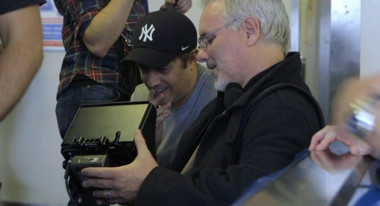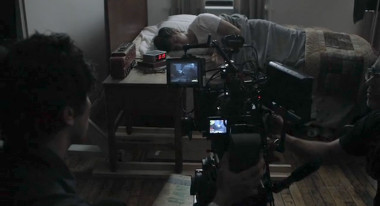 Back to selection
Back to selection
Shooting the Short BART: an Interview with the Director and DP
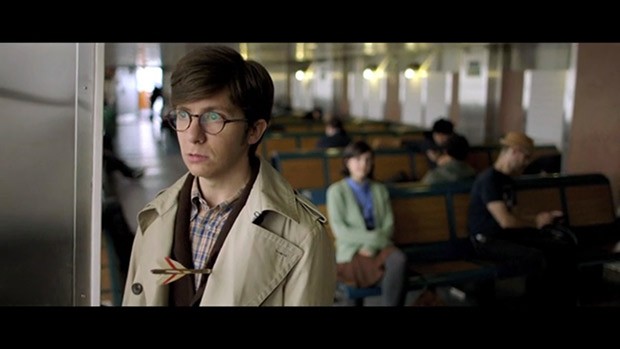
When L.A.-based director Rich Landes was offered the chance to shoot a short narrative piece for Canon he jumped at the chance. Landes has extensive experience as a commercial director, but this was a chance to direct a narrative based on his own idea, and with few restrictions from the “client.” But first he had to come up with an idea and treatment in two days. Then he had to fly to New York and cast, find locations, and hire a DP in four days, and then shoot the whole thing over the course of two days. None of this was made easier by the impending arrival of Hurricane Sandy, which hit New York only a couple of hours after they wrapped principal photography. Said DP Peter Simonite, “Rich and I were both so absorbed with the work, it was just another thing; you have to get 48 set-ups a day and also there’s a hurricane coming.”
With the help of Simonite, Landes created BART, a sweet four-minute short that tells the story of a man with a broken heart who finds love on the Staten Island Ferry. The entire piece was shot on the Canon C100, recording to AVCHD in C-Log, edited in Final Cut Pro and graded in daVinci Resolve.
Landes and Simonite spoke to us about the production of BART, working together for the first time, and the Canon C100:

Filmmaker: Can you tell us about yourselves?
Landes: I’m a commercial director. I’ve been doing that for a few years now, and BART was my first narrative in a longer-form piece.
Simonite: I’ve come up through the ranks working in different capacities in camera departments on movies and commercials.
Filmmaker: What exactly were you asked to produce?
Landes: The brief was “do you have anything that could transcend all language barriers, something that had a lot of visuals to it, and told a story with some emotion?” I had an idea that I had been thinking of about a guy who lost his girlfriend on 9/11 that meets a girl on the subway. It was a sad sort of story, but he comes alive in the end when he sees her.
I reached out to a writer friend of mine, Tyler, who is a copywriter in advertising, and he came up with the arrow idea, and that put the whole story together. But I was very reluctant; I was thinking, they’re not going to go for this guy with an arrow in his chest [laughs]. But in the 11th hour I just went for it, and they liked it. And then I had to explain to them how I would do it in a way that wasn’t spoofy or silly.
Filmmaker: Did you write a script? What was the development process?
Landes: I got this on Friday, and they said I had to present it on Sunday night at 6:30. I called my writer friend and we wrote a script. Well it’s not really a script; it basically described all the different scenes the character would be in. I had to write an extensive treatment and visual reference as well.
Filmmaker: And how did Peter get involved?
Landes: We were awarded the job and went to New York, and we were going through various DP reels. One of the Canon people suggested Peter. I looked at his stuff and I loved it, and they weren’t sure if they could get him because he’s in Texas. The next day he was there in the morning, which was amazing. That to me was really one of the things that helped make this whole thing.
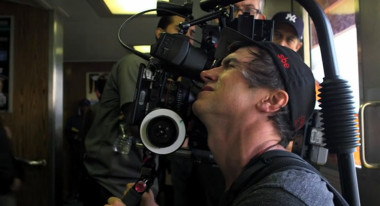
Filmmaker: Peter, what were you told?
Simonite: [Canon] called me and said, “Hey, there’s a guy Rich Landis, who’s directing this short using the C100 and we’re doing it this week and why don’t you come out and be a part of it?” I was excited because I looked at Rich’s other work, which I thought was super cool, and I said yes.
Filmmaker: You had a treatment. What was the pre-production?
Simonite: Rich had done a lot of preparation. He had really thought it all the way through in great detail, which was very fortunate because coming on to a project like this as late as I did, it took me a minute to get inside his head and see how I could help.
Filmmaker: How long was the shoot?
Landes: It was three days total.
Simonite: The third day was mostly B-roll and pick-up shots around the city.
Filmmaker: How were the actors cast?
Landes: I reached out to some people here that I knew, and nobody wanted to do it for the money. So I went to New York with no actors and I was kind of freaked out! We reached out to a casting director we know there and I gave them a description of what I was looking for, just basically types, age ranges. They sent me 40 guys and 40 girls on video. I got those on Tuesday and I went through them and picked the two that I wanted. Then I just had a call back and brought them in to see them next to each other, and I knew that they were the ones.
That’s the one thing about doing commercials, you’re used to working in a fast pace, and you have to make decisions on your feet and you’ve got to be pretty sure about what you’re doing. Actually the number of compliments that I get from the whole thing, aside from the photography and the camera work and all that stuff, is [about] the casting. They love the casting.
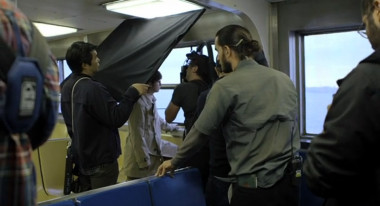
Filmmaker: Who are the actors?
Landes: The guy is Seth Kirschner. He’s been on 30 Rock and I didn’t even know it, I didn’t even look at the resumes! When I cast I just look at people’s sensibilities and demeanor. The girl is Grace Rex, she’s on The Good Wife, which I also found out later.
Filmmaker: How many locations were there?
Landes: We did the Staten Island Ferry and an office building, and then we did Bart’s house, which is multiple parts, so all told it’s probably six different locations in the total piece. You know it was a crash course because we were fully gun-to-the-head style — 95 set-ups in two days kind of thing.
Filmmaker: You said that in the original idea you imagined a guy on the subway. How did you end up on the Staten Island Ferry?
Landes: When we got the budget my production manager said that there was no way we were going to get the subway. It was more cost effective to do it on the ferry, with the caveat that we were allowed 12 people and no equipment, and that’s one of the reasons why the camera was great because it’s very low profile and we were able to get on and off easily.
Simonite: We had very minimal equipment, like a flag and a light pad, and no tripod. It was just the camera and natural light.
Filmmaker: How many crew did you have on this?
Landes: We had about 30 crew, but on that particular day we only had 12 people. The extras were a lot, but that was separate.
Filmmaker: What lenses were you using?
Simonite: Rich had envisaged this as a softer looking piece, and one of the things that we thought about at one point was using some of the older Canon lenses to have a softer look to them. But we ended up using the Canon cine primes primarily for the usability, and some of the EF lenses for the shallow focus. We used the range of cine primes, but mostly we were on the 24mm.
Filmmaker: What were you doing for monitoring?
Simonite: We had a couple of different options. We had a standard 17″ monitor for some of the stage work, and when we were on the boat we had a little handheld monitor that plugged into the port in the back.
Filmmaker: Peter, what cameras are you usually shooting with?
Simonite: Depending on the job, we’ll shoot with everything from film to Alexa, but probably the Alexa is the most common camera that gets used.
Filmmaker: What did you think of the C100?
Simonite: It was a great tool for telling Rich’s story. It worked perfectly for what we were trying to do on this shoot. We were able to be very fleet as Rich described, getting on and off the Staten Island Ferry every 20 minutes and trying to block and stage and shoot scenes. And I thought we were able to produce really cinematic soft focus images. I’m really happy with it.
Landes: It was my first time ever using an HD camera. I was scared to death because I’ve only used film. Everything I’ve done has been film because I just know it, and I feel safe with it. When this came up I was really scared it was going to be a glossy video look…and when you see it you’ll see that it really shocked me.
Simonite: It seemed like Rich really wanted it to be softer and a little more organic feeling than some of the other HD video that he had seen so I was pleased we were able to do that with the camera.
Filmmaker: What was it like shooting on the ferry?
Landes: It was surprising, because it’s so heavy; there was no rock really at all. The windows on the bottom level are very low to the water so when you see some of these two shots we did and you see the water going by, it was really amazing. I couldn’t have had better luck with that as opposed to the subway. The subway is so played out, and I think sometimes you just get lucky.
Simonite: I had seen Doug Chamberlain speak at a Canon event and he had done something pretty smart; he’d used gyros so that he could run around on a plane and shoot pretty stable shots, so I took his lead on that and used a little gyro on the back of the camera, which helped.
Landes: Because it takes place over a period of time in his life – going to and from work – we had seven or eight different wardrobe changes, and we jumped around different days. It was insanity. The actors were changing…
Simonite: You had to get off and then run onto the other boat with our flag and our bounce board, and I think we didn’t make it on to one of the boats and we got stuck… It was a very intense shoot; it was almost like one of those 48-hour projects.
Filmmaker: Rich you said this was you first narrative. What was different about doing this?
Landes: I had been focusing on 30-second commercials, and now that I’ve done this I total want to change directions. I’ve never had the handcuffs taken off like this. When you do commercials you’re pretty much controlled by an agency and the client. They’re there with you, making the decisions, and you’re basically just putting creative input into their project.
With this they basically told me I could do whatever I wanted, which frightened me at first because I’ve never had that experience before. I started to feel a little bit of the freedom and I was like, “This is just unbelievable, I get to pick my own music, I get to pick my own title, I get to cast whoever I want,” and they didn’t stop me once. I was just waiting for them to say, “Rich, wait a second, dude, why don’t you do it this way,” but once they gave me the job they just let me do whatever I wanted, which has never happened to me before.
Simonite: That was one of the coolest things about this project, because even though it’s a trial run for this camera, the Canon guys were very supportive of Rich and us to tell a story the way that Rich envisaged it without any strings attached.
Landes: I do all my work before I shoot anything, so I tell the whole story in storyboard form and a visual reference, right down to the color of a lamp, I’m that crazy. I think they started seeing that come to life, and that gave them comfort to just keep letting me go because I delivered exactly what I told them I was doing.
Filmmaker: How did the two of you work together?
Landes: It was kind of like love at first sight, when you meet somebody who gets what you’re saying, sensibility wise. I could reference a scene from a particular movie and Peter would know exactly how that was done. He understands color and understands all the composition and the things I was trying to create as far as the mood and the feeling is concerned. I felt like he was really on my side and I felt safe and I felt like he got me and we had a great collaboration. I hope there’s more to come because I like using the same people. Once they get you, they get you.
Simonite: Connecting with Rich, who’s very focused and very passionate and prepared about what he’s doing, I immediately recognized that this is a person who has that concentration and attention to detail that I’m going to really take a lot of pleasure from collaborating with and I hope support.
Filmmaker: And you were shooting before, and after Hurricane Sandy?
Landes: We finished shooting Sunday night at 2AM. The hurricane hit about a couple of hours later, and then we were stuck in New York. We shot our pickup day on Wednesday, and we went on the Manhattan Bridge and got shots of the city and some pickups in apartment buildings. We just kept working all the way through even though the city was like a war zone. We had to buy batteries at B & H, who happened to be open. We kept shooting, and went home on Saturday.
Simonite: One of the shots in the film was done at the MJZ office when there was no power. We just set up by a window. I would add that despite the storm and the speed at which we had to make this, it doesn’t come across that way at all. It’s actually a really refreshing, sweet film.
Filmmaker: What about post-production?
Landes: We edited it back here in L.A. We got Michael Penn to do the music. He’s an amazing composer, and he did us a solid favor. I think the music definitely helps tell the story. I knew the music was going to be really important because when you don’t have dialog to tell your story it’s the music and the colors that really move it along.
Filmmaker: Given the short time, was there anything that you didn’t manage to do or wish you could have done differently?
Landes: I can’t believe I’m going to say this, but I don’t think that there’s much [more] we could have done. I’m happy with it, and I’m really not happy with anything. I’m very tough on myself, but I just genuinely like this because I think it delivered what it was supposed to deliver. I went there with a fire to perform, which I do for everything, but I really did it for this because it was a crash course, and it was hard but we did it, so it’s a special thing for me.
Rich Landes
Peter Simonite
Seth Kirschner
Grace Rex
See also: Behind The Scenes on BART: a Narrative Short Shot with the Canon C100
